The following photo shows a brick terrace house, advertising a saddler and harness maker, but in a rather poor condition. We are in Monmouth Street in Seven Dials and the photo was taken by my father in 1984.
Thirty six years later and the building is in a far better condition, with the advertising signage restored.
I was going to try and be clever and title the post “Seven things about Seven Dials”, but as I dug into the history of the area there are far more than just seven things of interest.
The sign is advertising the business of B. Flegg, a Saddler and Harness Maker, established in 1847.
B. Flegg was a William Flegg and the building in Monmouth Street was not his only premises. I suspect this may have been his central London sales room, where he would sell everything needed for the thousands of horses that kept London moving in the 19th century.
William Flegg’s main location seems to have been on the Old Kent Road in south London where he occupied numbers 585, 586 and 592. Adverts in the South London Chronicle stated that he had “Stable utensils of every description. Whips and all kinds of horse clothing always on hand. A waggonette to let, to hold four or six persons”.
It could be that saddler and harness maker was a family trade and that the family were from south London. As well as William Flegg there was an H. Flegg, also a saddler and harness maker, who had premises at 7 Deptford Bridge, but had to move to 2 Church Street, Deptford in 1880 due to rebuilding of the bridge over the Deptford Creek.
Flegg is not that common a name so I suspect that H. and William Flegg were related.
The final references to the name Flegg as a saddler are in 1905, when a George Flegg, aged 40 and a saddler of 654 Woolwich Road, Charlton was found drunk in Woolwich Road and fined two shilling and six pence, or three days if he did not pay the fine.
Monmouth Street is the street leading off to the south from the central Seven Dials junction, just to the east of Charing Cross Road and south of Shaftesbury Avenue. The seven streets radiating out from the central junction form a distinctive pattern on the map (Map © OpenStreetMap contributors):
The layout of the streets around Seven Dials has not changed for a very long time. The 1895 Ordnance Survey map shows the same distinctive layout (‘Reproduced with the permission of the National Library of Scotland’):
Going back to a 1755 map of the Parish of St Giles’s in the Fields, and the same distinctive layout is in the lower left corner:
Detail of Seven Dials from the above map:
Comparison of the maps tells us a number of things about Seven Dials. Firstly the streets radiating out from the central junction have changed names over the years:
In 1755 the street name stayed the same as the street crossed the central junction, however by 1895 the names had been changed slightly to give each branch a distinctive name, so St. Andrew’s Street became Little and Great St. Andrew Street.
By 2020, the 1755 approach of extending the same street name across the junction had been put back in place, and a new set of names given.
When William Flegg was in Monmouth Street, he would have known the street as Little St. Andrew Street.
The maps also tell us something about the pillar in the centre of the junction. The 1755 map shows the pillar, however by 1895 the pillar had gone, and there was a Urinal in the junction. By 2020 the pillar was back in place.
I will come on to this later, however for now, lets take a walk along the southern section of Monmouth Street.
The terrace of houses with William Flegg’s premises in the centre:
Looking up Monmouth Street from the southern end of the street:
Buildings along the western side of Monmouth Street:
The rather magnificent Two Brewers pub, Monmouth Street:
The streets around Seven Dials are now full of clothing and jewelry shops, restaurants and cafes. Mainly small, one off shops rather than the large chain shops that can be found across much of London.
We can also walk through the street in 1895 and look at the businesses that occupied the houses by using the 1895 Post Office Directory.
We can see William Flegg occupying numbers 16, 17 and 18, so not just the single house with the sign on the wall. The numbers are different to today’s numbering as this was when this branch of Monmouth Street was Little St. Andrew Street.
The directory has a few abbreviations of which I have not yet found the meaning such as the “size ma” for George Oliver at number 11 and “rms” for John Thomas Blake at number 20.
This was a street of small manufacturers and traders, trading in everything from bread and meat to birds and fishing rods.
At the top of the southern branch of Monmouth Street is the Seven Dials junction, where the seven streets come together:
The streets running around the central Seven Dials junction were built during the later part of the 17th and early 18th centuries. Thomas Neale obtained the lease for the land in 1693. Prior to this, the area was already built-up, but with Cock and Pye Fields occupying the space where part of Earlham and Monmouth Streets now run.
In the following extract from William Morgan’s 1682 map of the city of London, I have marked the location of the central Seven Dials junction with a red circle.
There is only a single street that remains to this day. White Lion Street can be seen running through the red circle. This would stay White Lion Street when the central junction and seven streets where completed. Today White Lion Street is Mercer Street.
Note also that the street that would become Shaftesbury Avenue was Monmoth Street in 1682.
The central feature of the junction of the seven streets in Thomas Neale ‘s plans was a pillar.
The British Museum has a copy of the original drawing of the pillar designed by Edward Pierce (©Trustees of the British Museum):
The text at the bottom of the drawing states “A Stone Pillar with Sun Dyals to which are directed 7 streets in St Giles’s Parish commonly called the Seven Dyals, formerly a Laystall”.
The word Laystall can refer to a place where rubbish or dung is deposited. It can also refer to a place where cattle are kept. This might be related to the location of the sun dial being at the entrance to Cock and Pye Fields in the 1682 Morgan map.
The 1895 Ordnanace Survey map shows the central junction without the pillar. It had been removed over 100 years earlier as it had become the focal point for so called undesirables and in 1773 the Paving Commissioners ordered the removal to prevent this nuisance.
The pillar eventually turned up in Weybridge, where the pillar, without sun dials, can be seen today at the junction of Monument Hill and Monument Green.
By the 1980s, the majority of Seven Dials was derelict, and there were plans for the demolition of the majority of buildings in the area. Restoration plans were proposed by the Seven Dials Monument Charity and fortunately this approach was supported, otherwise we would see a very different Seven Dials today.
There were efforts to bring the original pillar back from Weybridge, however the local council refused.
Architect A.D.Mason designed a new pillar based on the original design by Edward Pierce, which included making measurements of the original pillar in Weybridge. The new pillar and sun dials were unveiled on the 29th of June, 1989.
The new pillar would become the focal point for the restoration work of the streets surrounding the pillar, and the work has been a considerable success with the area packed with people in more normal times.
Looking down the southern branch of Monmouth Street from the central junction:
The Crown pub facing the central junction, between the northern branch of Monmouth Street and Short’s Gardens.
A plaque on the pub shows how the solar time shown by the pillar can be converted to Greenwich Mean Time:
The new central pillar:
The Cambridge Theatre (opened on the 4th September 1930), between Earlham and Mercer Streets:
The Crown pub, then Short’s Gardens, then Earlham Street:
During the first decades of the 1700s, the new area of Seven Dials quickly become a reference point for news reports and a sample of reports between the years 1723 and 1749 tells us much about life in these brand new streets:
21st March 1723: There is just finished by Mr John Noble, living near Seven Dials, an Organ, which by using bellows only, without the help of an Organist, sounds several Tunes to Perfection.
6th February 1725: One Murphy, a Centinel in the 2nd Regiment of Guards, was on Saturday last seized near the Seven Dials, on Suspicion of being concerned in the robbing of the Chester Mail. One of the Chester Bags (out of which letters were stolen) having been found near a hedge, was brought to the General Post-Office yesterday morning.
1st November 1729: Late last night one Welch, who buys and sells old Cloths, was set upon by two Street-Robbers at the Corner of St Andrew’s-Street, near the Seven Dials, who took from him in Cloths and Money to the value of seven pounds and upwards.
There was a pillory at the Seven Dials in the early decades of the 18th century, and the risks of being sentenced to the Pillory can be seen from the following newspaper report:
22nd June 1732: Last night, the Coroner’s Inquest upon the body of John Waller, who stood in the Pillory at the Seven Dials in the Parish of St. Giles’s in the Fields last Tuesday, and brought in the Verdict wilful murder with unlawful weapons.
Later in 1732, the person who had killed John Waller was included in a list of those sentenced to death, but the report does not provide any background as to why he was murdered:
14th September 1732: Richard Griffith, for being concerned in the Death of Waller who was killed in the Pillory at Seven Dials.
24th November 1733: Last Saturday Mr Rambert, a Coal Merchant in Tower Street, near the Seven Dials, received an Incendiary Letter threatening to set his House on Fire, and kill him, if he did not leave twelve Guinieas in a certain place mentioned in the letter, which was written in French. That night Mr Rambert left twelve Half-pence in the Place, and at about One in the morning, some Neighbours who watched to see the consequence, observed four fellows pass by, when one of them took up the half pence and walked off with the imaginary prize. We hear nothing however of their being pursued.
Strangely, 16 years later, there is a report of someone being arrested for writing incendiary letters:
24th November 1749: On Saturday night, one Franks, a shoemaker, was taken at a house near Seven Dials, on the Oaths of his Accomplices, for writing Incendiary Letters to several persons, in order to extort Money thereby.
People living in the streets leading off from the Seven Dials pillar could be very wealthy:
15th October 1741: On Saturday last died at his House in Earl-street, near the Seven Dials, Mr. Philips, a Distiller, said to have died worth 30,000 pounds, and on Thursday Morning his Corpse was carried out of Town, in order to be interred near his deceased relations, about three miles from Nottingham.
29th November 1744: The same day, Hannah Moses, otherwise Samuel, the Widow of one of the three Jews who were hanged about three sessions ago, was committed by the same Gentleman to New-prison, and her accomplice, Benjamin David Woolf, to Newgate, for stealing out of the shop of Mr John Barber, a Silversmith, at the Seven Dials, an Ingot of Silver.
19th May 1749: A few days since a Sailor went into a Chandler’s Shop in Earl-street, near the Seven Dials, to ask for a Lodging; but the man telling him there was none to let, he asked for a Halfpenny-worth of Tobacco, which as the Shop-keeper was serving, he drew his Hanger, cut him down behind the Counter, and made off; and yesterday the unfortunate man died of the wounds he received.
25th August 1749: Two Sawyers belonging to Mr Neale’s Yard in King’s-Street, Seven Dials, quarreled and fought, and one of them, by a fall, fractured his skull and died immediately, and the other being carried before a Magistrate, was by him committed o New-prison, Clerkenwell.
By the late 19th century, many of the streets around Seven Dials were crowded, with many poor occupants. Gustave Dore drew the entrance to Monmouth Street from Seven Dials. People crowd the street, shops and basements with shoes for sale line the side of the street and children play in street, blocking the path of a carriage (©Trustees of the British Museum).
George Cruikshank had earlier produced a drawing around 1836 as an illustration to Charles Dickens’s Sketches by Boz. The drawing shows two women being urged to fight in front of a gin palace in Seven Dials (©Trustees of the British Museum):
Despite the impression created by Gustave Dore, Charles Booth’s poverty map of London, between 1898 and 1899 shows most of the streets around Seven Dials as “Fairly comfortable. Good ordinary earnings”, although the dark blue along Queen Street is classed as “Very poor, casual. Chronic want”.
The following photo from the 1897 publication “The Queen’s London” shows a street leading up to the Seven Dials junction. The photo gives a different impression of the area to that of Gustave Dore’s drawing.
By the 1970s, the area was very much in decline. The streets were all open to traffic, there was no central pillar and cars would pass across the central junction between streets. Some of the space in the streets was used for purposes that seem very strange when looking at the area today.
In 1974, a Texaco petrol station occupied the space between Earlham and Monmouth Streets. This is the space to the right of my earlier photo looking down the southern branch of Monmouth Street from the central junction,
Image credit: London Metropolitan Archives, City of London: catalogue ref: SC_PHL_01_152_74_21025
There is much to discover in the streets that lead off from the central junction of Seven Dials. I have only covered the southern branch of Monmouth Street and a general history of area. It would take a very much longer post to cover the whole area.
There are a couple of houses in the southern section of Mercer Street that I want to show. They are a pair of late 17th century terrace houses that date from the original construction of Seven Dials. This is number 27 Mercer Street:
And number 25. Both are Grade II listed.
The view looking up Mercer Street towards the pillar from the junction with Shelton Street:
During the summer and autumn period, many of the streets have been closed, providing more space for pedestrians and the cafes in the area.
Seven Dials is usually very busy. Tourists, visitors to London, those visiting the theatres and restaurants of the West End add to those who live and work in the area.
in the run-up to Christmas, the streets around Seven Dials are crowded, and a couple of years ago I photographed a Saturday evening around Seven Dials. Here are three examples.
Looking up Monmouth Street towards the central junction:
Around the central pillar:
Crowds and the Cambridge Theatre:
Many of the buildings of Seven Dials have been redeveloped, and the original pillar is now to be found in Weybridge, but the general layout is still the same, and some of the original buildings survive.
I suspect that Thomas Neale would be rather pleased that his Seven Dials development is still here 300 years later.

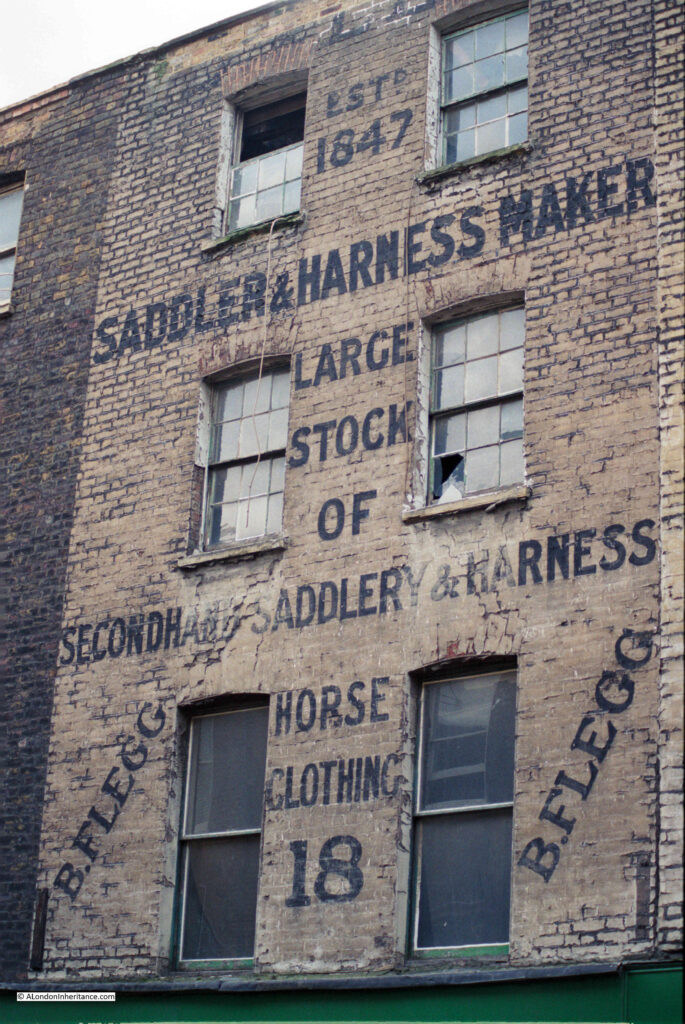
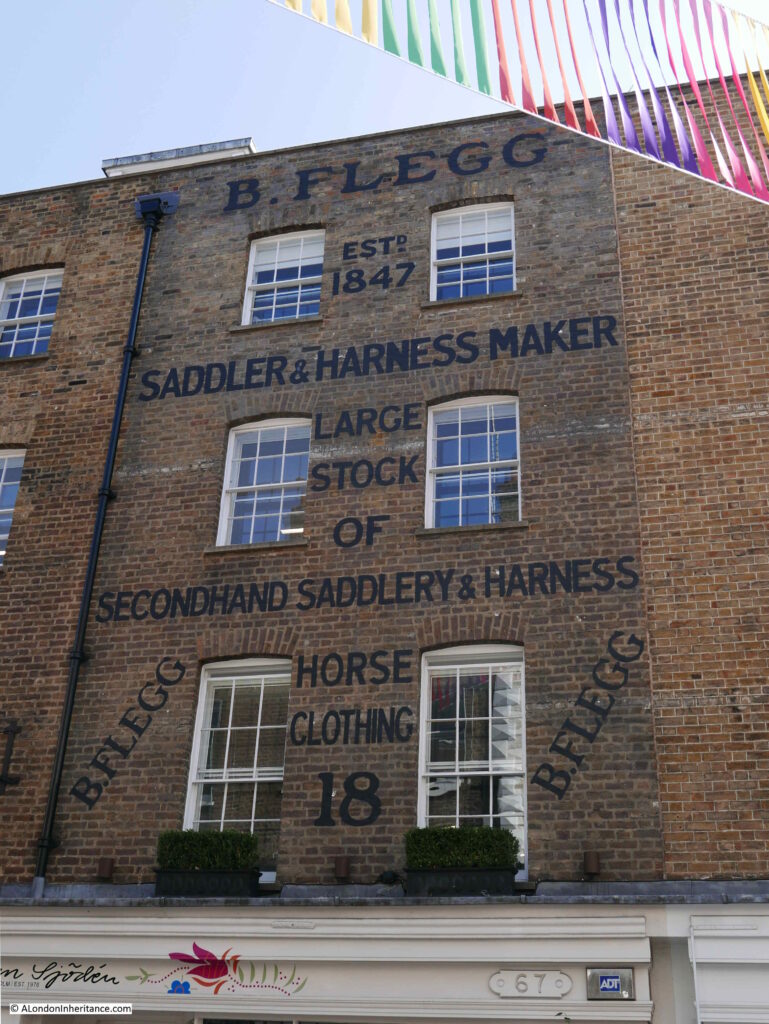

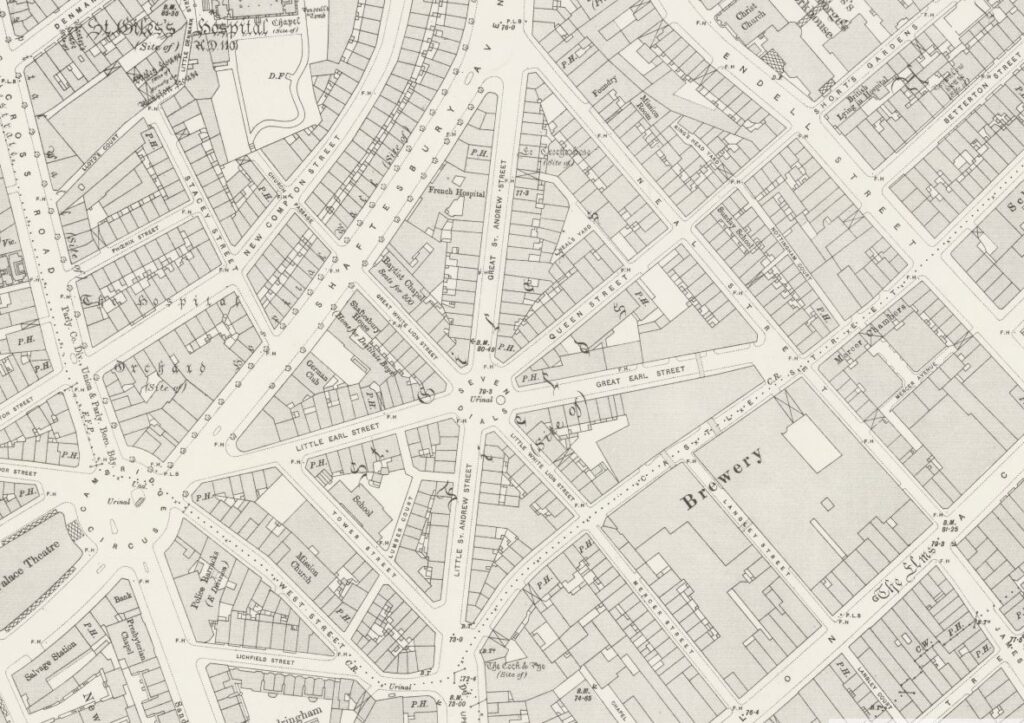
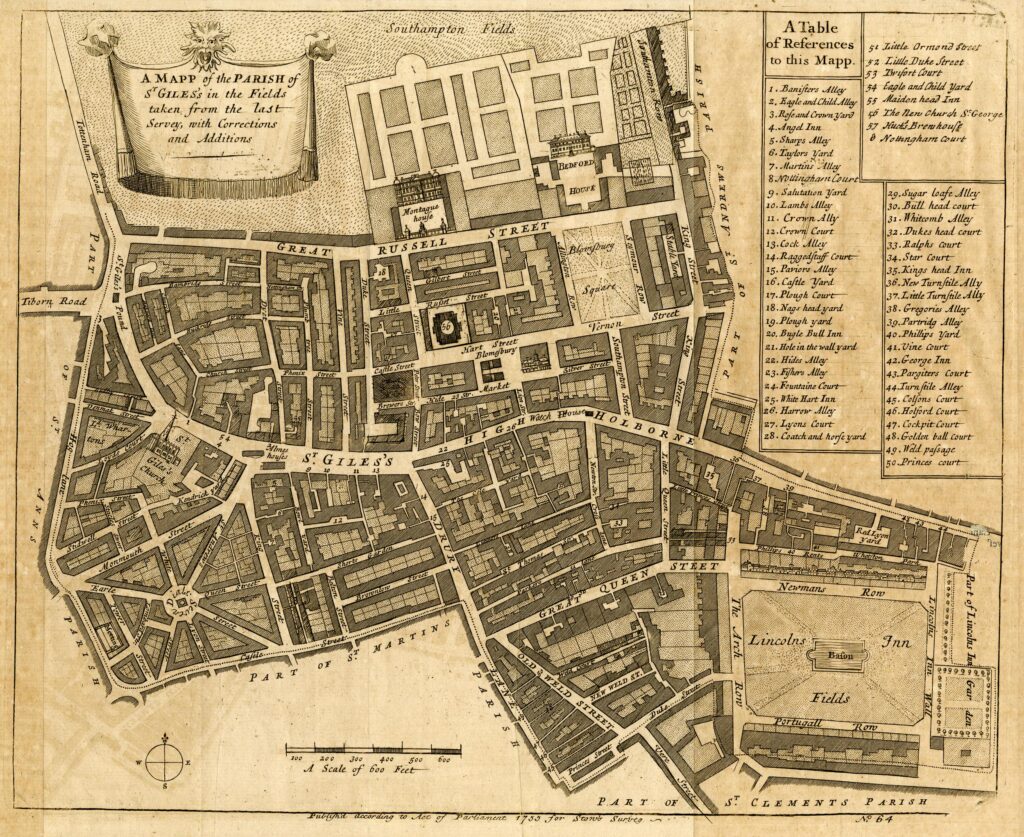
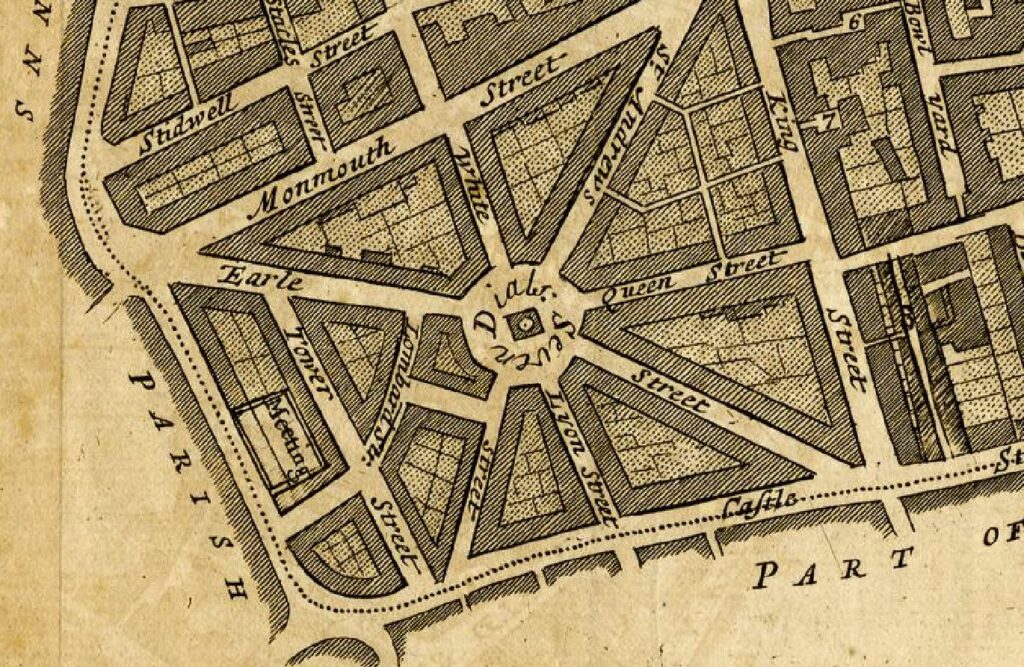


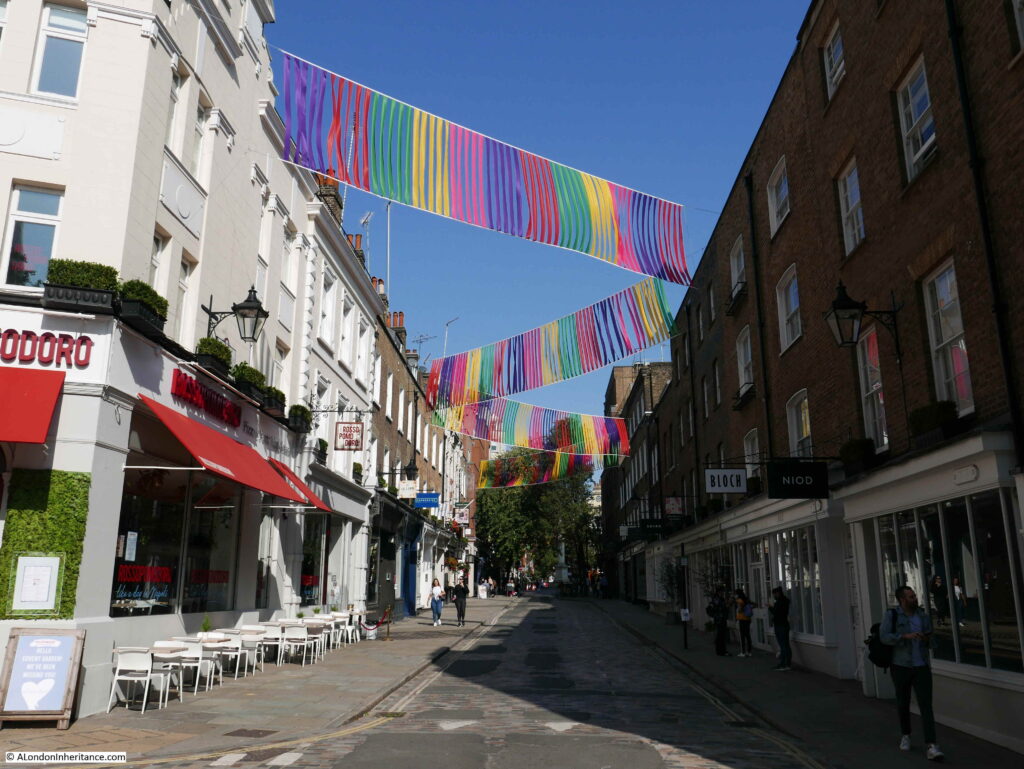
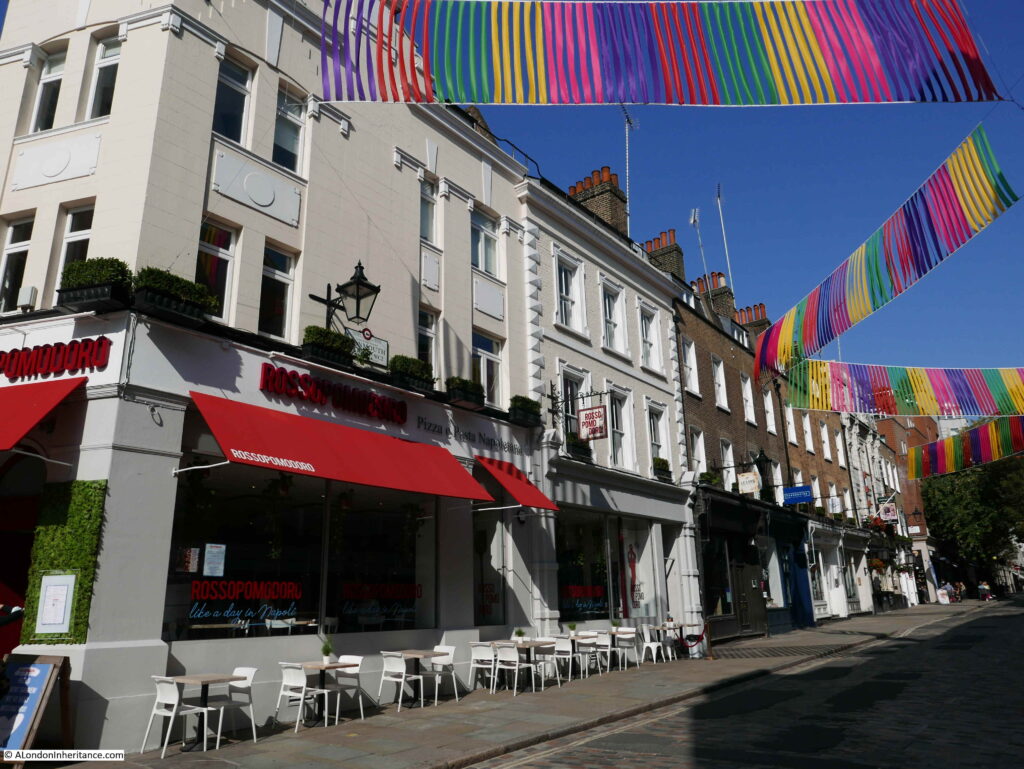




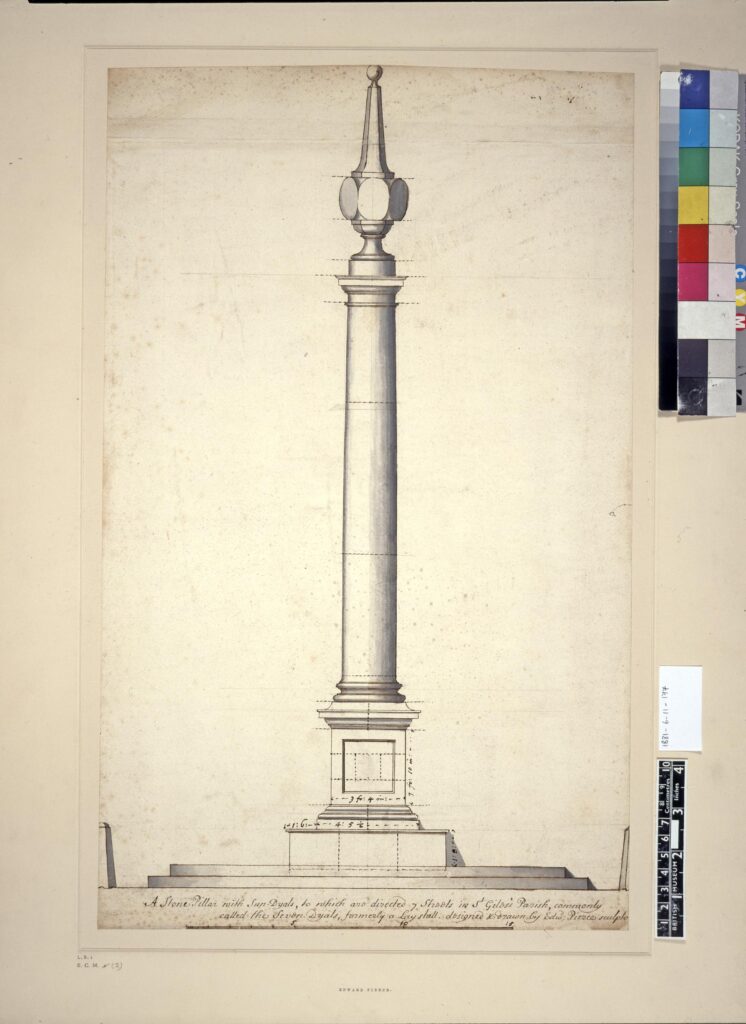

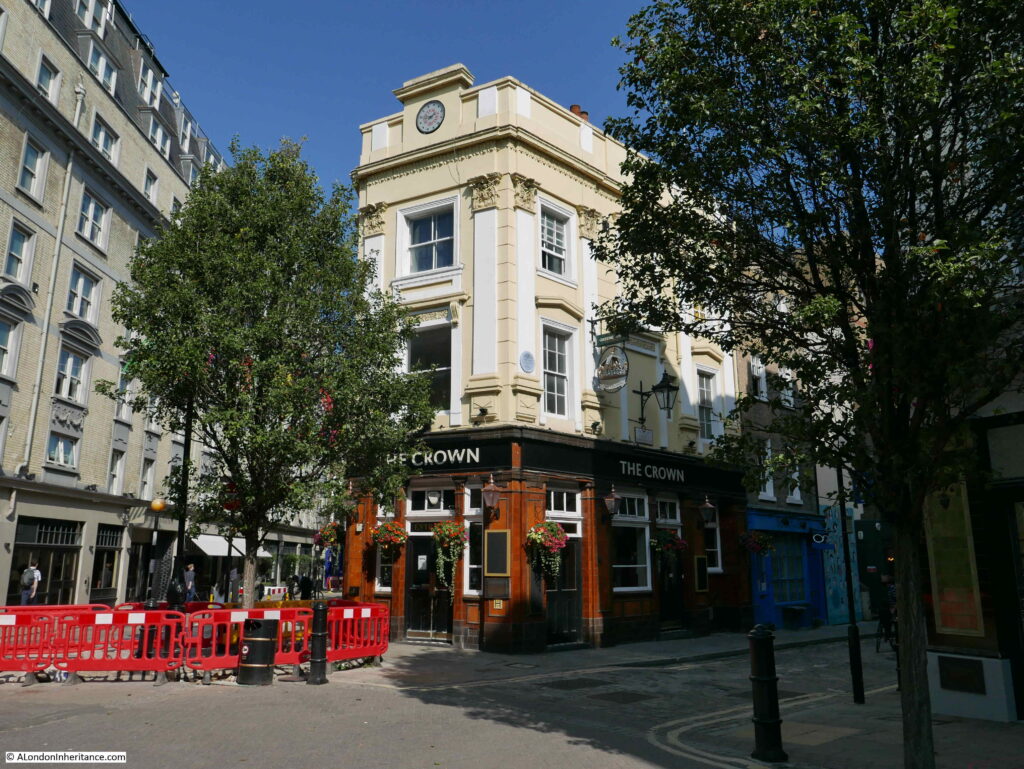


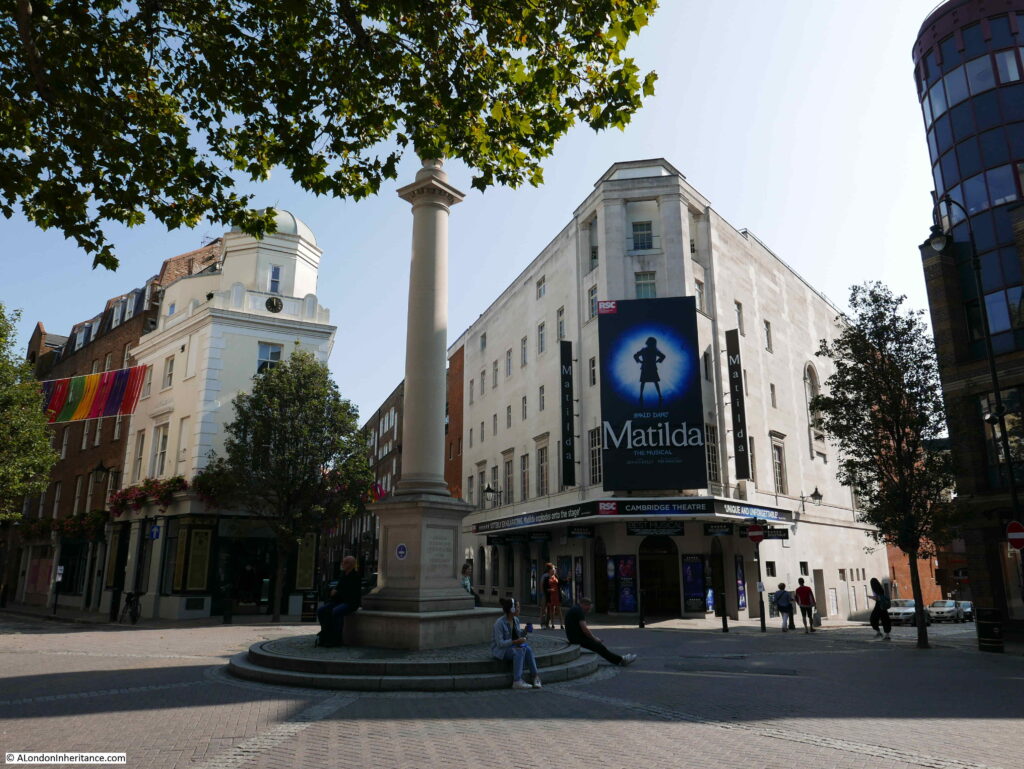
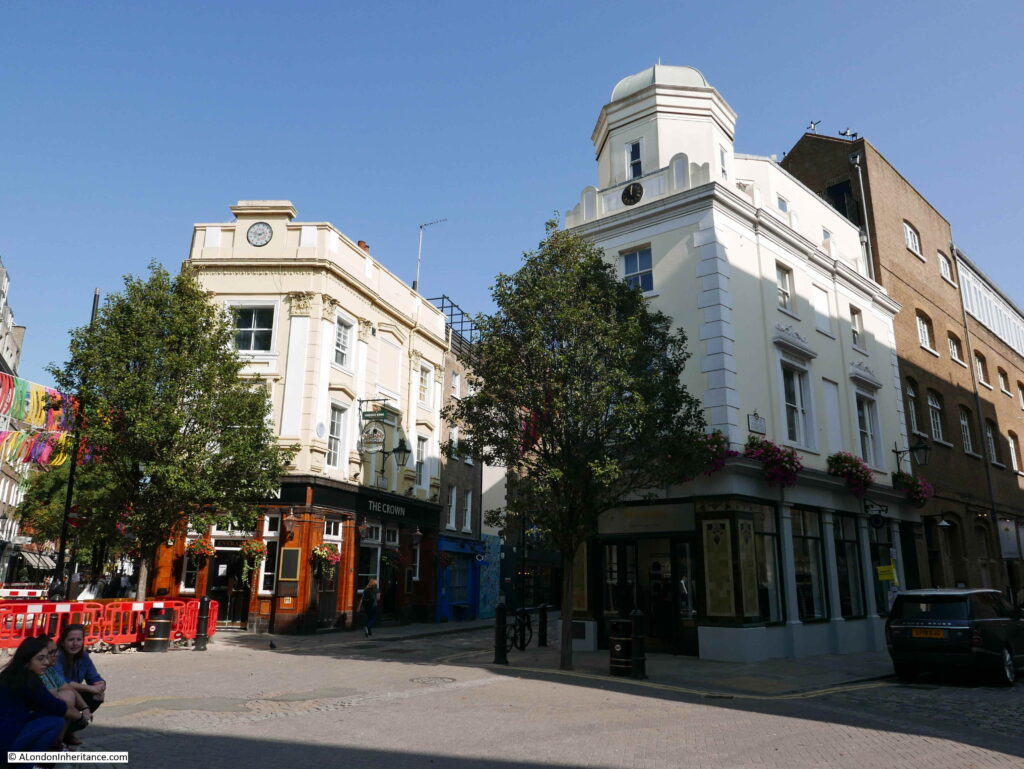
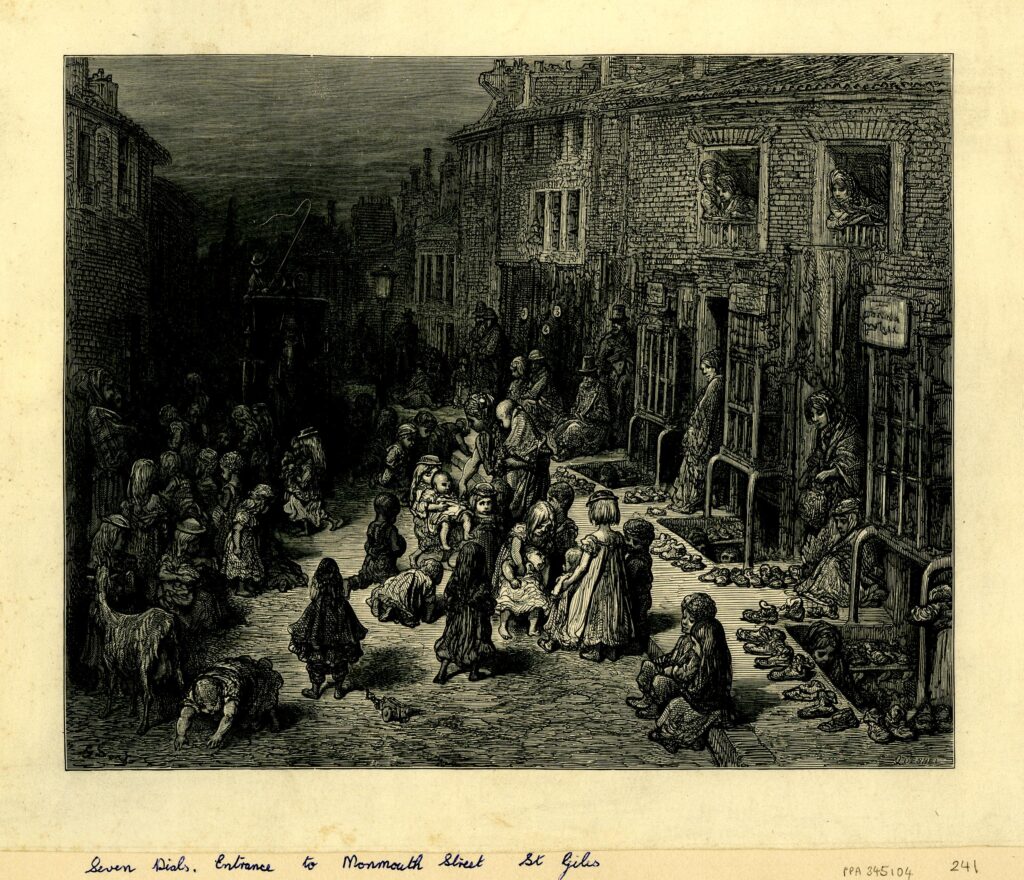
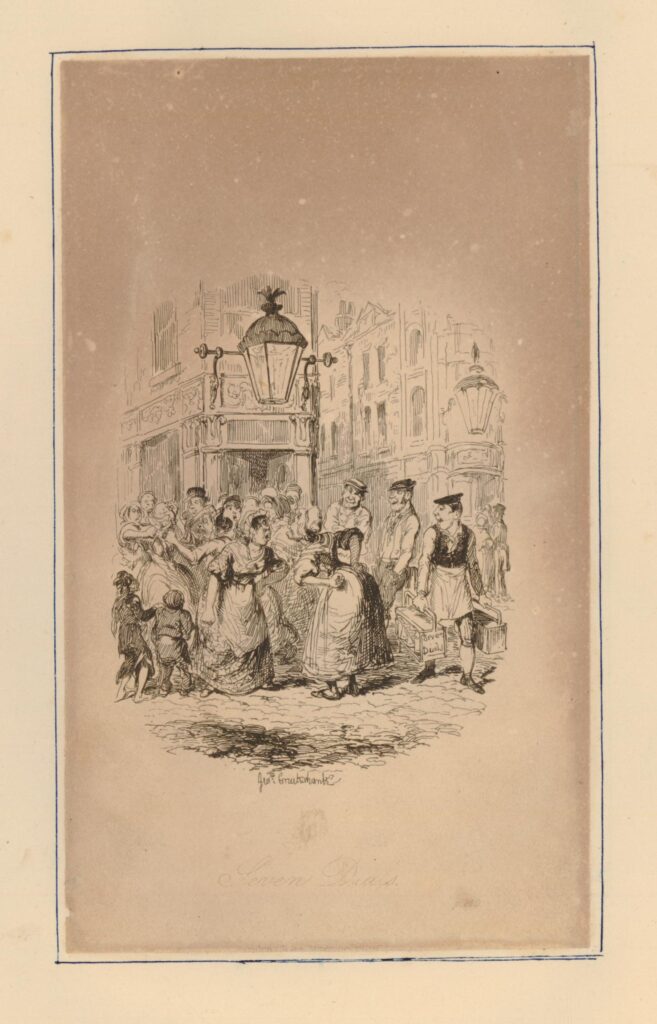

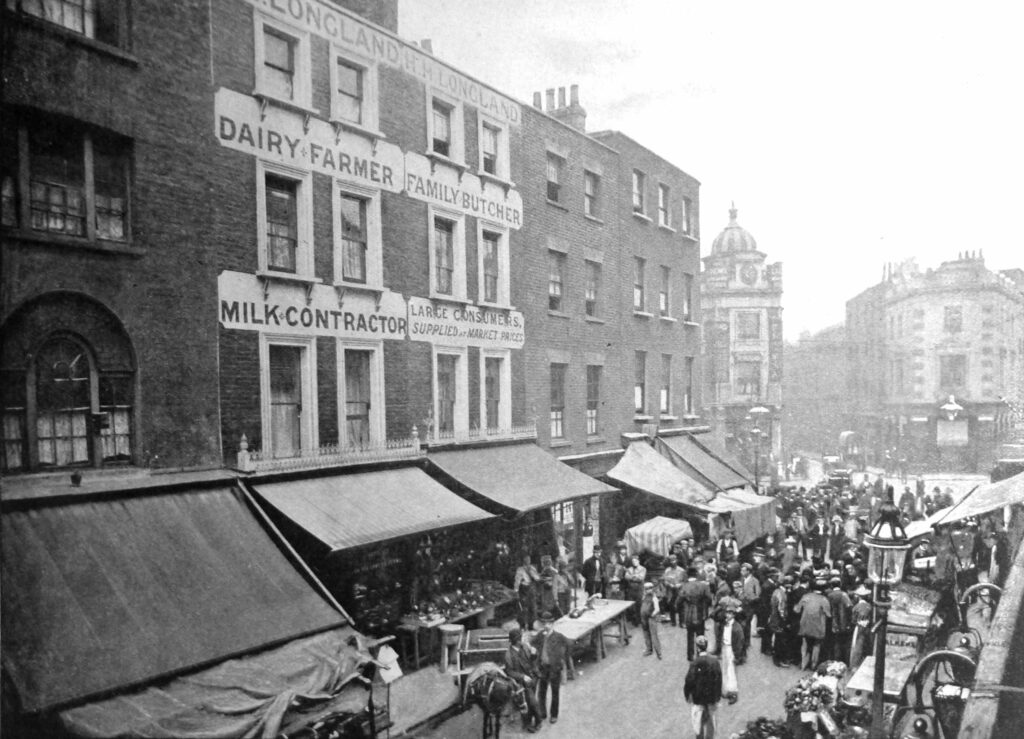
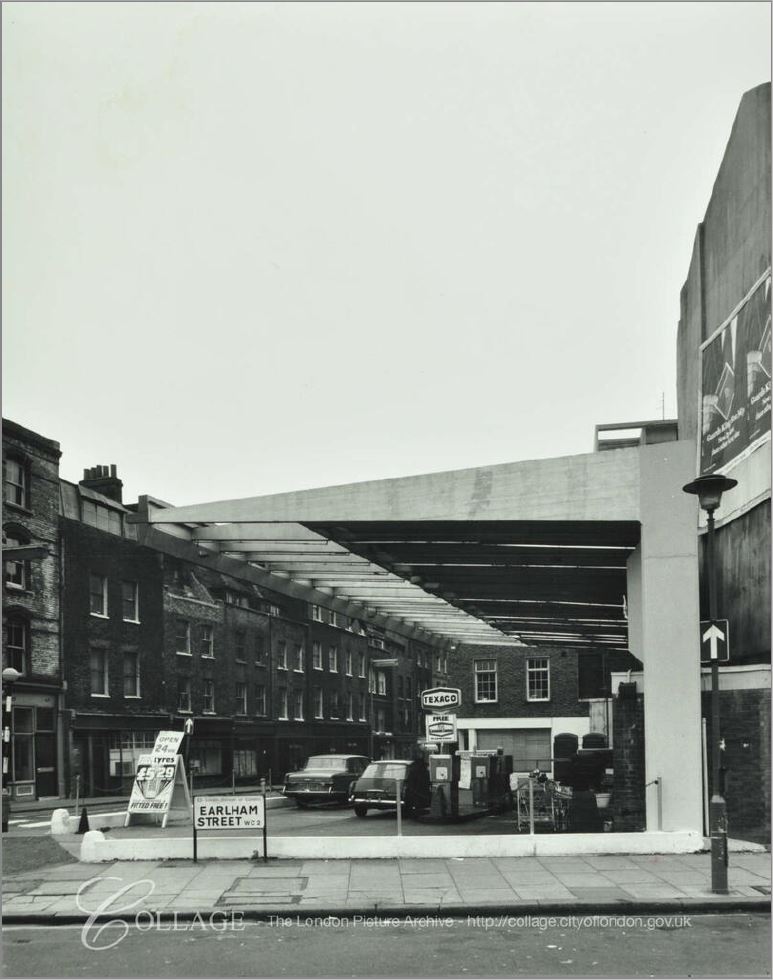

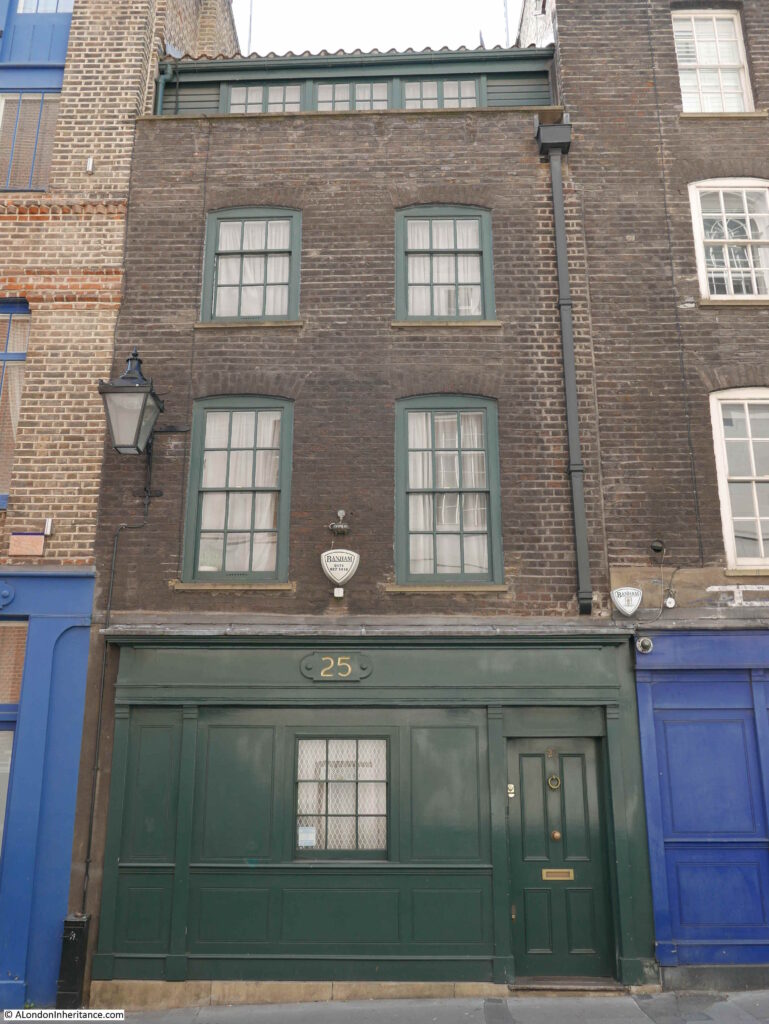
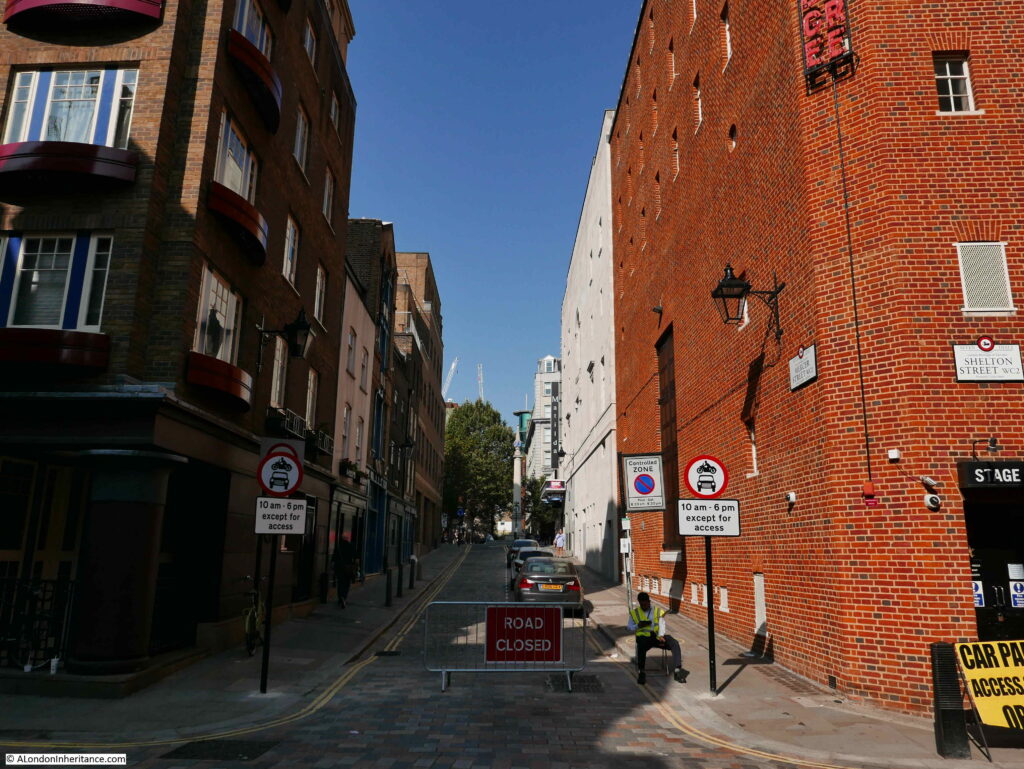
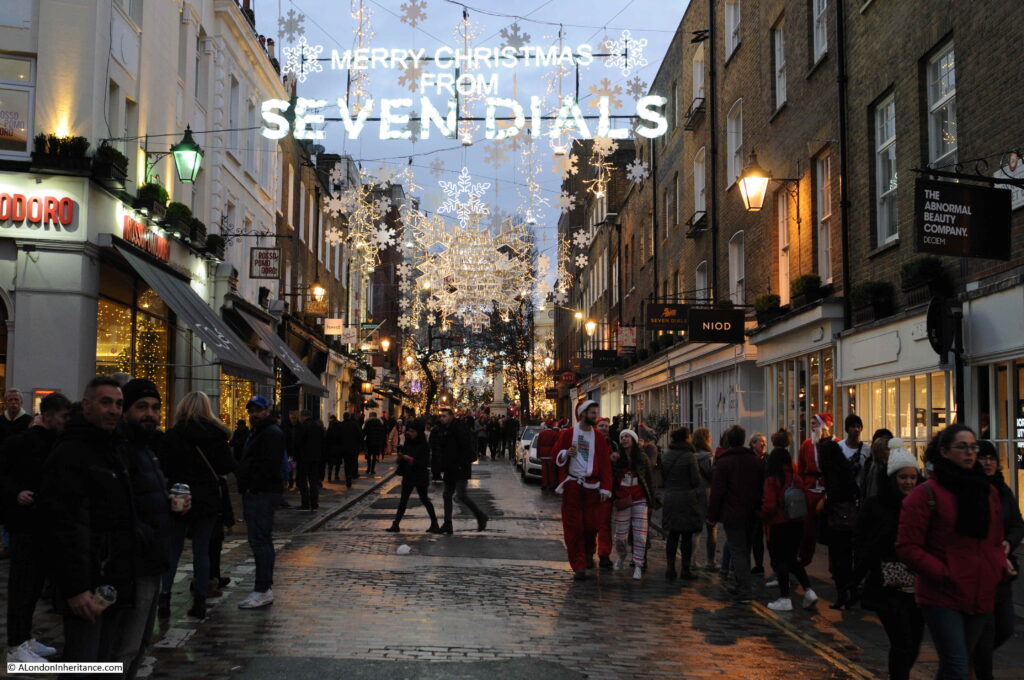
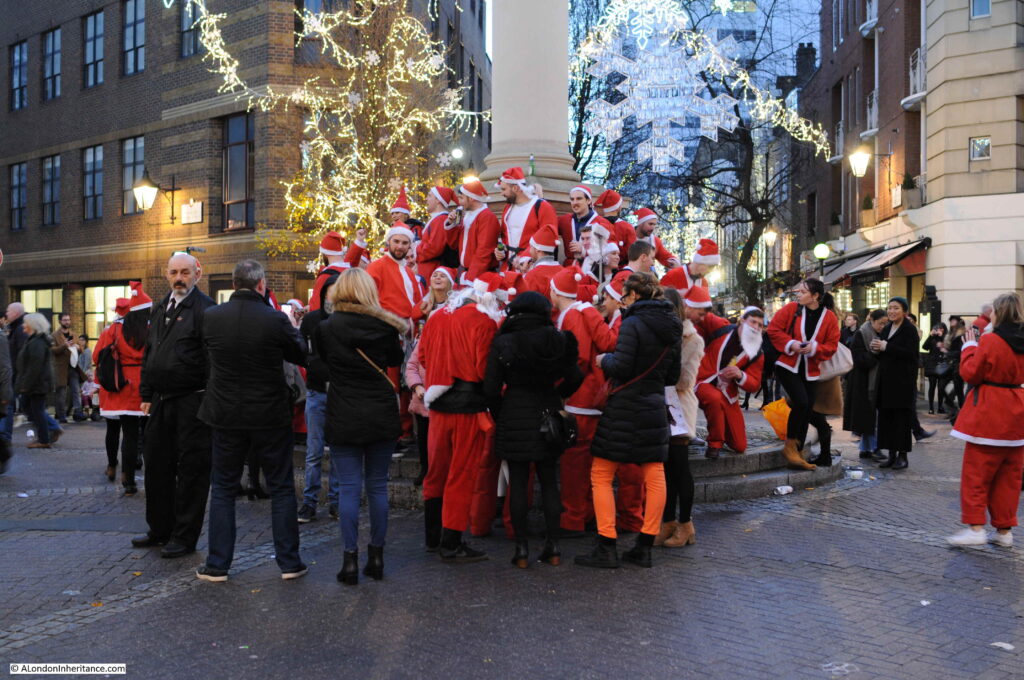
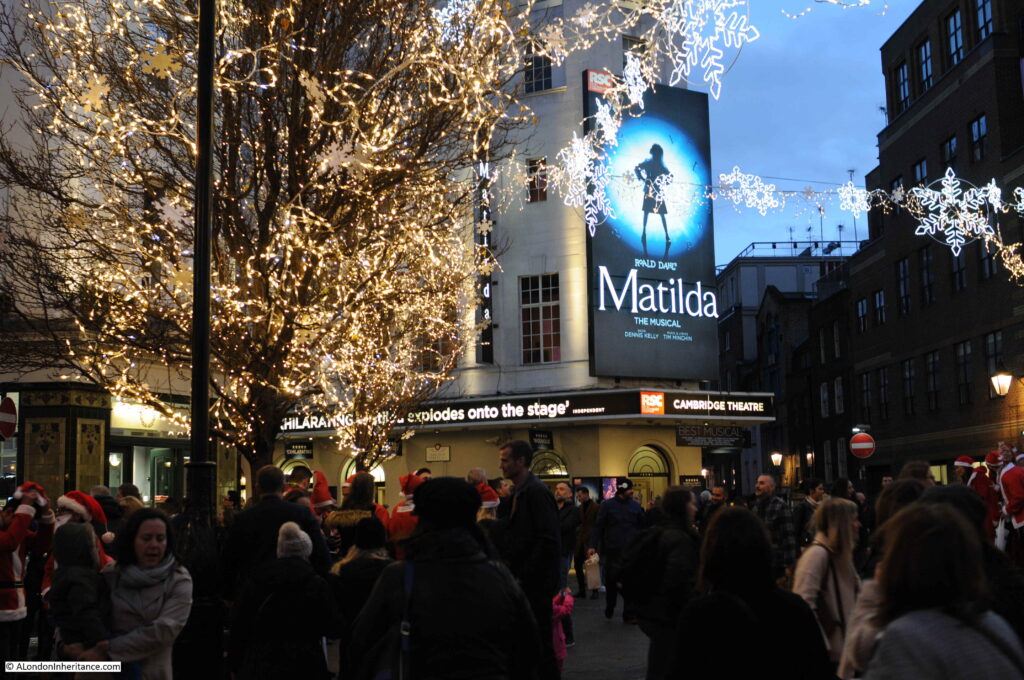
A conjecture about the following sentence:
“The directory has a few abbreviations of which I have not yet found the meaning such as the “size ma” for George Oliver at number 11 and “rms” for John Thomas Blake at number 20.”
“Gold size ma” = manufacturer of size – a kind of adhesive used for priming a surface before applying gold leaf.
“Coffee rms” = coffee rooms ? A place for meeting and drinking coffee?
Another great post. Such an interesting area. I live nearby and stumbled across the original Seven Dials pillar only last year when visiting a relative in Weybridge. A curious discovery.
On the mysterious abbreviations – my guess would be ‘coffee rooms’ and ‘gold size maker’ (or manufacturer)
Keep up the good work
At this time the dining room of an hotel was often called the coffee room. So I guess this is a set of dining rooms, what today would be a restaurant, rather than a place for just drinking coffee.
At this time the dining room of an hotel was often called the coffee room, so I guess this was what we would call a restaurant, rather than a place for only drinking coffee.
Another great post. Always interesting. I came across you through Arnhem post but like the London stuff even though I live in Middlesbrough. Actually went to the Cambridge theatre a few years ago and dined nearby.
A wonderful post. I can’t get over the Texaco petrol station plonked right in the middle of an ancient street!! The 1970s was definitely another country…
Texaco petrol stations routinely gave Green Shield Stamps, or if you were very lucky, double Green Shield Stamps !
And also I collected smurfs from that Garage as I lived in Monmouth street, Then Shelton street during the 1970s and 1980s
At this time the dining room of an hotel was often called the coffee room, so I guess that ‘coffee rooms’ signifies a set of dining rooms, or what we would call a restaurant, rather than a place for only drinking coffee.
Thanks David. That makes sense.
For 20 years (well, until this March) Monmouth Street was very much one of my routine commutes to Westminster from Euston. I have walked up and down it countless times and never, to my eternal shame, noticed the Flegg advertisement, nor, despite having patronized the Two Brewers magnificent upper stories.
And as others have already posted, astounding to think there was ever a Texaco garage at Seven Dials. Nor would I have realised that the area was in decline in the 1980s. It’s shown none of that history to me in the twenty years I’ve know it (although as admitted above I must walk around brain dead….)
Neals Yard, just off the Seven Dials, a haunt of mine in the late 1970’s, it was mainly Neals Yard Bakery, for organic bread and whole food snacks. It was run as a cooperative. It had a wonderful atmosphere and after a long day visiting record shops for new wave, reggae and punk singles around Soho, I would go to Neals Yard buy my wholemeal loaf and sit and eat one of their massive Veggy pasties.
There is a relatively short history of Neals Yard from the late 1970’s
https://nealsyardlondon.co.uk/history/
So interesting please keep going your articles are a real insight into the past. Thank you.
Great read, thank you
Working in the West End during the late 1960’s I do remember seeing the petrol station.
Always a good read on a Sunday morning.
Hello, thanks for this – most I already was aware of as I have researched this sign as part of my Ghostsigns of Covent Garden to Soho guided walk. The whole area has long fasinated me being as my first job in 1980 was near Seven Dials when the whole area was being renovated to become what we see today.
However, re the painted sign, I suggest the B is a ref to Benjamin Flegg who was listed at 16-18 Little Andrew Street in 1915.
I also like that in 1895 until at least 1915, just up the road at 7-19 there was another saddlers company (well, the area was littered with saddlers and leatherworkers!) – this one by the name of Parker Bros , then by 1915 shown as George Parker & Sons – possibly my ancestors?!
There’s a really good photo of Earlham Street approx 130 years ago within an information panel almost oppostite Tower Court.
Keep up the good work, Jane
Thanks for this Jane. I assumed the B was for Bill as a short form of William, as Wm Flegg is listed in the 1895 Post Office directory. However it does depend on when the sign was painted and you are right, it could well be for Benjamin Flegg.
Hi Jane, I am nee Parker and the saddlery you mentioned was originally in several buildings along Upper St Martin’s Lane. I was born above the shop so to speak in 1956 and at that point in time it was number 12 Upper St Martin’s Lane. Three floors, basement was tack room and packing room, middle floor was showroom with wonderful old wooden horse life size and cases holding jockey silks, tack etc with saddles displayed on the other side. When I smell leather I go back to childhood! There was an office and cloaks at the back of the shop. On the first floor was Lily who made the horse blankets etc with a room with a huge measuring table with rolls of cloth waiting to be cut up, then Stan who represented Holbrow polo sticks, and in the back room were Paddy and Mart, sitting amongst the odour of simmering glue, handmaking saddles, with gas flames on the wall to warm their needles before sewing the parts together. It was a wonderful place to grow up and yes, who knows you could be an ancestor of ours. Kindest regards, Susan Huskinson. My email if you are interested in responding is susanmh@ntlworld.com
I just noticed your spelling of ‘jewelry’ rather than the UK way; ‘jewellery’ – are you American?
No, not American. The WordPress spell checker defaults to US spelling and I sometimes miss a change. Hope to come on one of your walks in the future.
Thanks for doing this. It’s much appreciated
Fascinating, as ever. Thank you.
Neal’s Yard bakery in the early 1980s sold such exotic things as nori make and sour dough bread, as well as great “organic” muesli with brazil nuts and whole dates. I think the cooperative was at the vanguard of the regeneration of the Seven Dials area.
Mind you before them the area had some very interesting, if slightly shabby small enterprises; Mole Jazz, another shop selling american comics such as the creepy “Tales from the Crypt”, also a book shop selling books on the occult where you expected a Peter Cushing character to emerge from the shadows.
To illustrate that the area was at the lower end of the social scale in 1882, WS Gilbert in Iolanthe wrote
`Hearts just as pure and fair
May beat in Belgrave Square
As in the lowly air of Seven Dials’.
Disgraceful behaviour by Weybridge council…another example of local authority having too much power.
It appears that Gustave Doré and Blanchard Jerrold’s book on London (London, a Pilgrimage) was published in 1872 ( https://gallica.bnf.fr/ark:/12148/bpt6k10470488/f15.item ), so Gustave Doré’s impression reflects the area more than 25 years previous to the 1897 photograph reproduced. Might that explain the difference in atmosphere between the slum is Doré’s work and the (relative) prosperity in the photograph? Just a suggestion.
I would like to take advantage of the occasion to thank you for this wonderful blog, one of the highlights of my Sunday routine, and your hard work and erudition, in the hope that, post-Covid, we shall once more be able to visit London.
Hugely interesting post this am. I vaguely recall the petrol station – those were the days when you could actually buy petrol in central London – now buying petrol here is like hunting for the Snark.
I worked in Henrietta St and Wellington St for decades and saw Covent Garden change from being full of eclectic independent shops ,somewhat more eclectic near Seven Dials area (anyone recall The Kite Shop?) and more upmarket in the Piazza (David Mellor/ Elizabeth David) to a cluster of tiresome national shop chains when it was sold on: I think the buyer was General Accident.
The two houses in Mercer St were very dilapidated for many years and then as CG became a tourist location they were discretely refurbished and remain very discrete . I had no idea they are so old and from the original building plan – so very interesting.
Txs for another excellent post.
Thanks for this! I started work aged 15 at Odhams Press in nearby Endell Street in 1961, and would wander through this area in my lunch hour. I was seeing it in its decline and before the area was ‘regenerated’. Long Acre was still lined with fruit and vegetable wholesalers and some that activity spread into the Seven Dials area. In fact, I seem to remember in Monmouth Street or Earlham Street a firm who made and rented out market barrows. They had their name inscribed on the side in a kind of copperplate hand.
That was my one of my family’s business Ellen Keeley barrows in Neal St. We also had Ellen Keeley flowers in Shorts Gardens opp The Crown. I spent much of my childhood hanging around the Dials before the market moved out.
I was interested to note Comyn Ching being listed as gas fitters. I remember their showroom on the corner of Theobalds Rd and Red Lion Street in the early 70s – full of wonderful brass door fittings. I was always intrigued by their name which sounded exotic and un-english.
When I was at school in the 60s I used to temp in the summer holidays and worked for a company of paper merchants in Earlham Street called Leppard and Smith. Their escutcheon was carved in to the wall where apparently it remains, next door to what is now Belgo.
What a lot of work you put into your posts – a treat to read every sunday for a Londoner who no longer lives there but has fond memories. thank you.
Hi my late husband worked for Comyn Ching in Shelton Street early 1970’s until they retired around 1974 and sold out to another small company Nicholsons . Remember going there once with him and getting petrol at the Texaco !!
The names were very British .
Comyn is the old spelling of the Scottish name Cumming from where I live now in Moray NE Scotland and Ching came from Devon/ Cornwall.
Neals yard had a peanut butter making machine. Tubes were clear and hung above the counter so you could see the peanut butter being made, moving along the tube and delivered into jars
There is a business in existence today by the name of Neal’s Yard :-
https://www.nealsyardremedies.com/
The “Our Brand” page suggests that the business had its origins in Covent Garden.
Thank you so much for this! My Spong and Sinkins ancestors lived in Seven Dials for several generations…My 2nd great-grandfather Spong had a grocery store on Little Earl Street and lived nearby, while my Sinkins 3rd great-grandfather owned #10 Little Earl Street (where my Spong ancestors lived) and lived himself at 2 Tower Street.
I love all the history and photos you’ve included. I love learning as much as I can about the area from a distance (I’m in Canada).
I always love your posts. Especially when you’ve written about Covent Garden. I live off Drury Lane. (Kemble St). My boyfriend’s family used to live on Monmouth St. (Above a pet shop!) I love walking around Seven Dials. It feels old. I’ve been in all the pubs in the last few years. But they’re too expensive. (When they’re open!)
There’s a lovely 45min video about Covent Garden Market, made in 1972. Made just before their closure in 1973. It shows you the old businesses that were going to lose their premises. Very sad.
It’s called LIFE IN COVENT GARDEN FRUIT & VEGGIE MARKET DOCUMENTARY 1972. A lovely film. I especially love seeing the ‘old dears’ that used to go to the Cross Keys on Endell St every night. I love that pub. I go in there sometimes.
I’m so glad the glc didn’t win. They were planning on flattening the market, Maiden Lane & loads of beautiful buildings surrounding it. Totally demolishing lovely old streets like that would have been a sin. SO GLAD SEVEN DIALS & COVENT GARDEN HAVE SURVIVED!!!!
To my mind the “restoration” of the ghost sign for Fleggs has been done rather badly. A more sympathetic job would have retained the flaky charm of the old signage. I imagine the old sign was removed when the front of the building was sand-blasted and an attempt made to re-create it using modern materials.
Absolutely loved your visit to Monmouth street.
Thank you so much!!
I agree with Charles – the signage has been completely redone. The font and kerning are different. Looks a bit artificial now. Fascinating post, as ever!
Great article the Xmas pictures all most brought a tear to eye .
A fascinating post that gives me a taste of the city I love but probably will not return to for at least another year. The Christmastime photos especially break my heart knowing that people who do live there will not be able to enjoy the season in quite the same fashion this year.
Another fantastic post that is very personal for me as my Mum was born on the Dials (Nottingham Court) and we had a number of family businesses related to the flower market, in addition to my grandparents being bookies before that occupation was legal. I’ve been inspired to check out the Post Office directory for the history of some of the shops they had. Thank you
Hello from Canada,
My great-grandfather, Joseph Mackness, was born in Seven Dials in 1874; son of Owen Mackness and Charlotte Cooper.
Joseph sailed to the new world on his own at 12 (ish) years old in 1887. He settled in southern Ontario – near London and then in Peterborough. He was in the military serving in the Boer War and WW1.
I have been researching family history in order to prepare for an upcoming family UK holiday. Joseph’s grandson (my dad) will be there. Owen lived at: 63 Dudley Street (Monmouth/Dudley/Shaftesbury), Princes Street, Great Wilde Street, and King’s Head Yard – which I had had no luck finding until your post! It is behind Neal’s Yard (which weirdly makes my favourite rose facial balm of all time! ).
Anyhow, thank you for this post! This history and the quality of maps and images are all terrific.
Cheers,
Michelle
What a great history of the Seven Dials area – fantastic photos and maps. I am delving into some family history and discovered my great grandfather grew up on Great St Andrew Street in the 1860s and 1870s. His father worked in a piano factory – I’m guessing there must be one fairly local so will check out some directories. Many thanks.
Such wonderful online resources are all the more appreciated as I live in New Zealand!
For more information about Seven Dials visit the Seven Dials Trust’s website. The trust, formerly the Seven Dials Monument Charity had been instrumental in protecting the unique fabric of this historic area. http://www.sevendials.com
I am a collector of map postcards and recently came across a lovely example produced by the Shaftesbury Hotel of (44 or 43-47) Great St Andrew St in the early 1930s in which the Seven Dials area is featured with all its theatres identified. An internet search for the hotel produced little information other than it was apparently built c. 1920 and was still operating in 1953. It was owned by and had the intriguing telegram address of “Unafraid Westcent”.do you or any of your readers have any further information about its history, including when it closed and what happened to the building? Any help would be much appreciated.